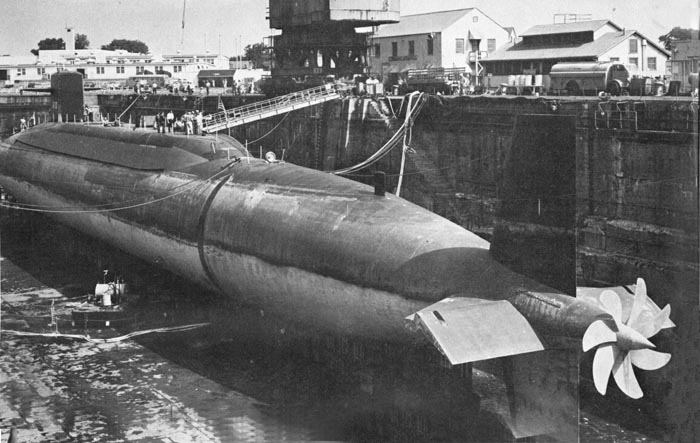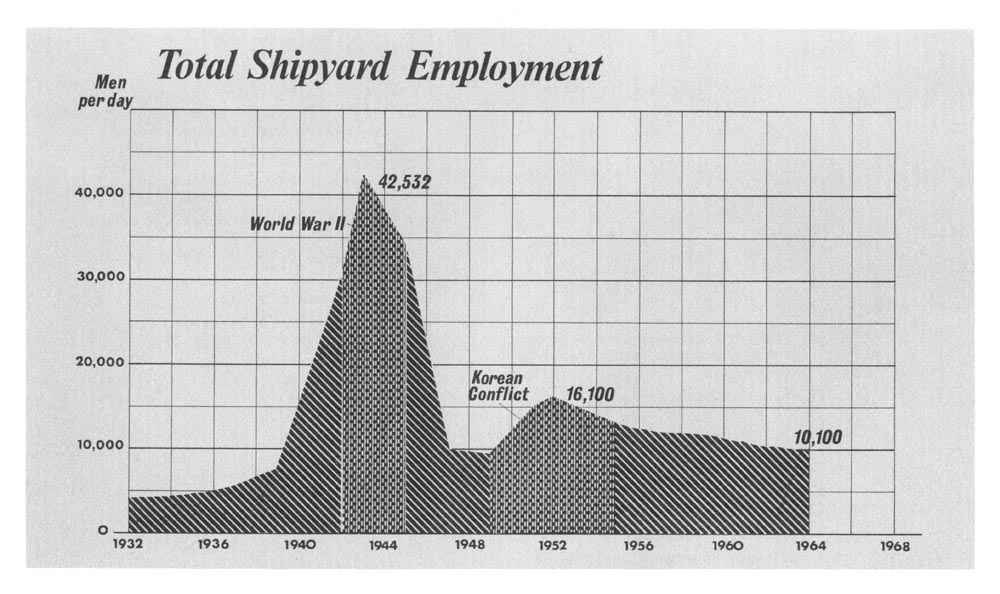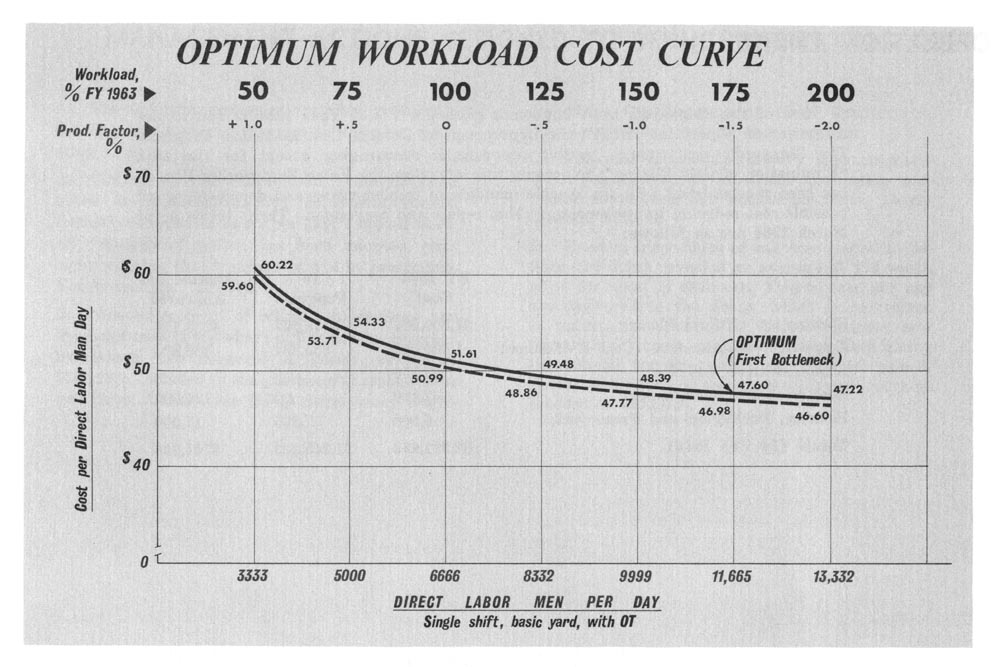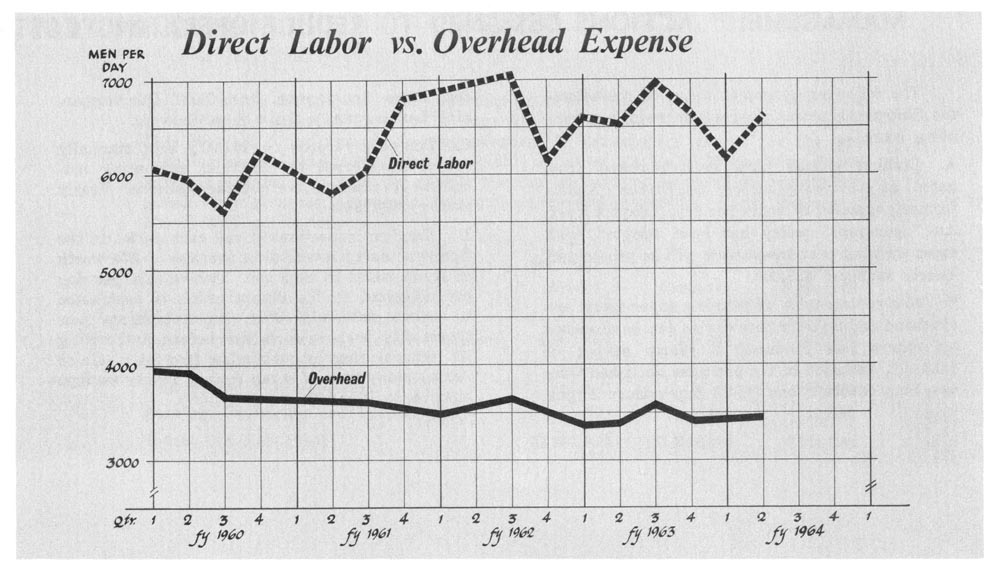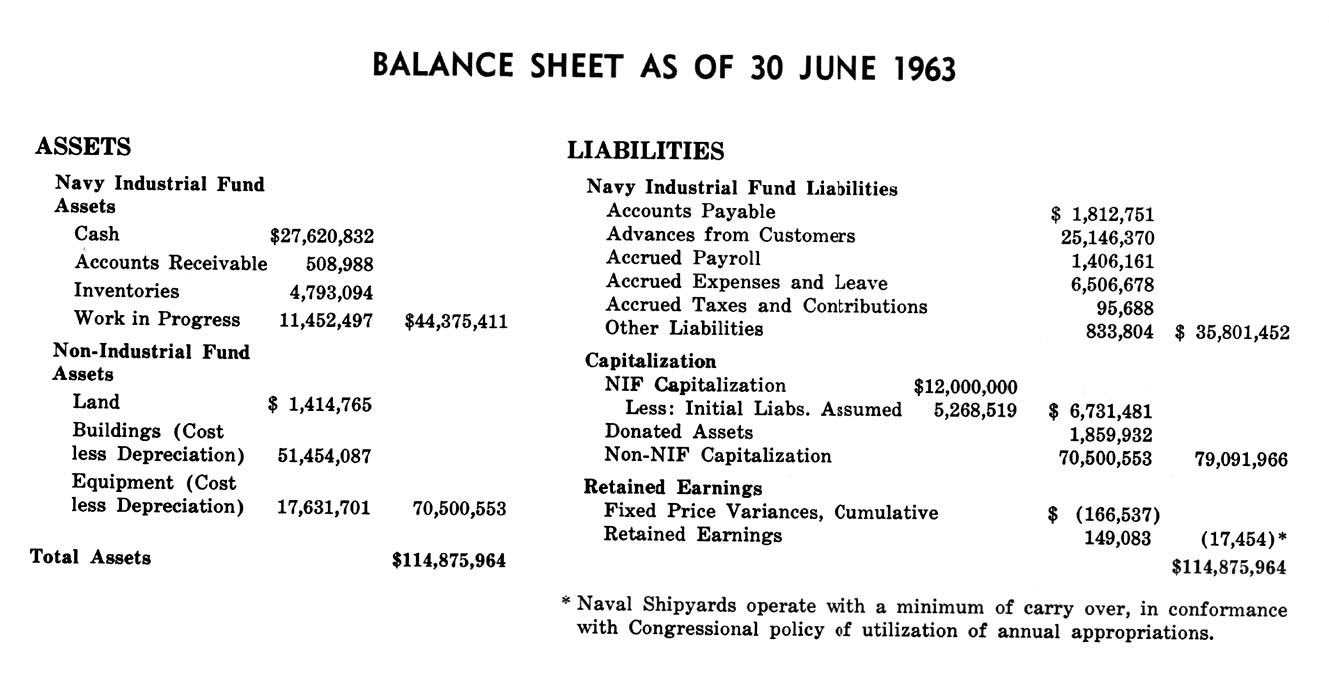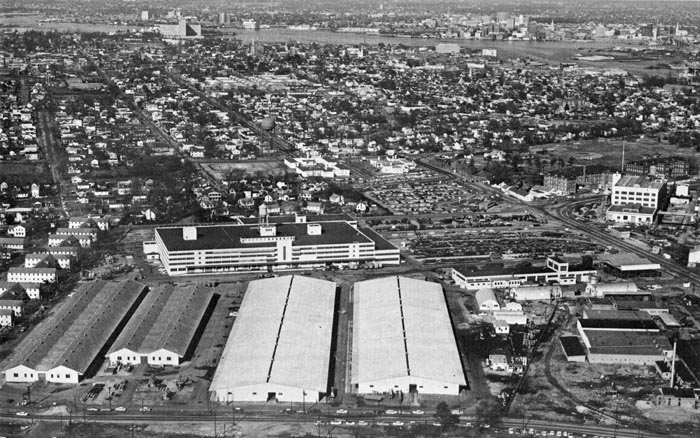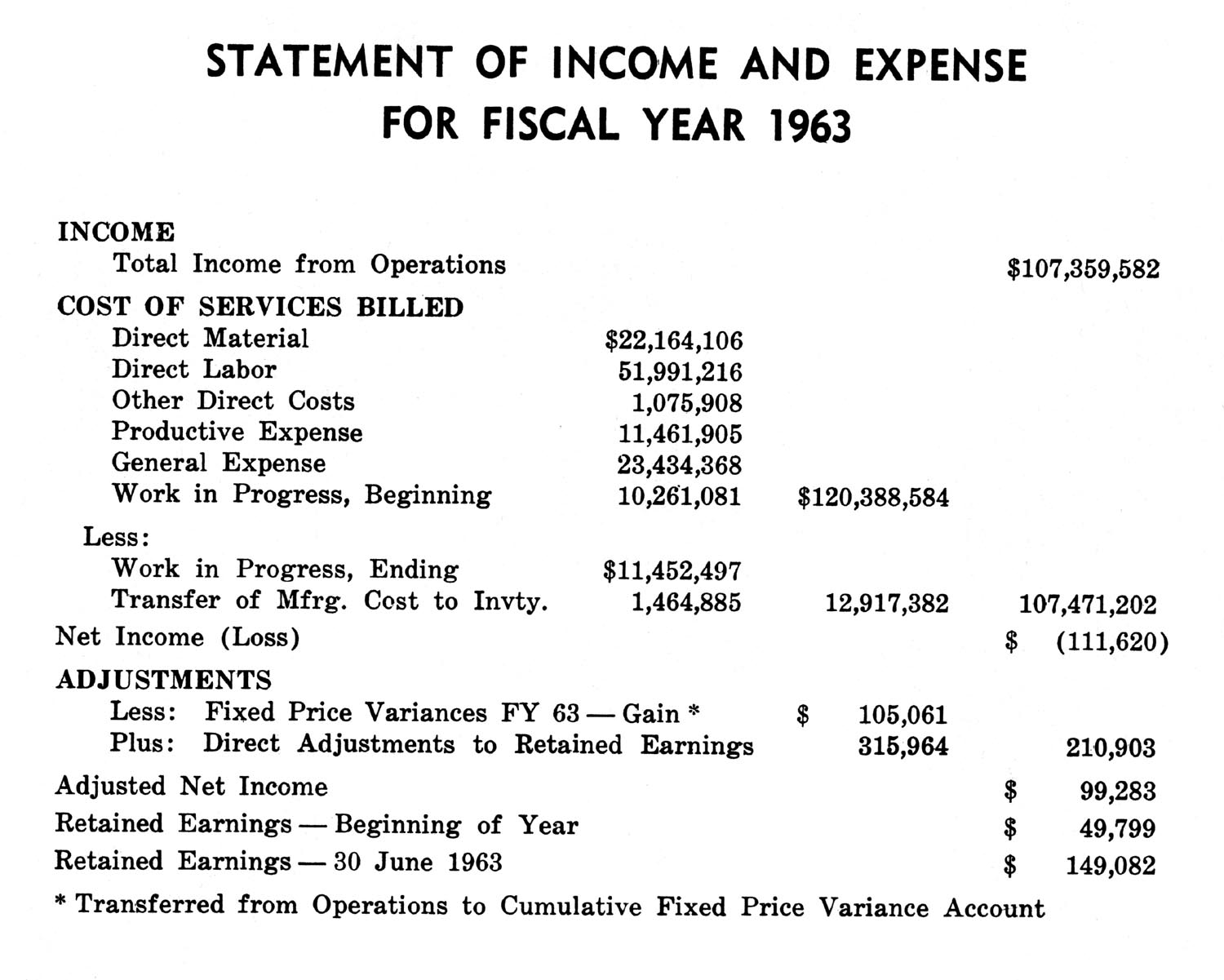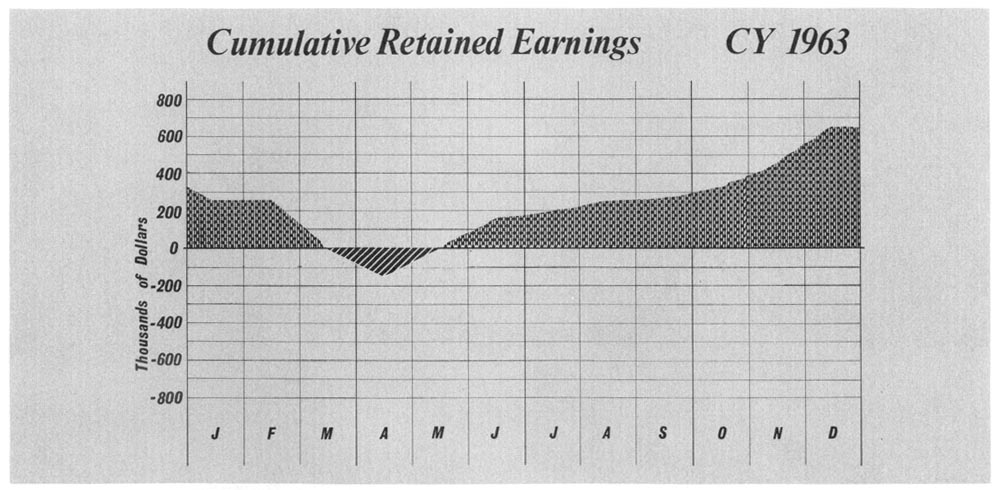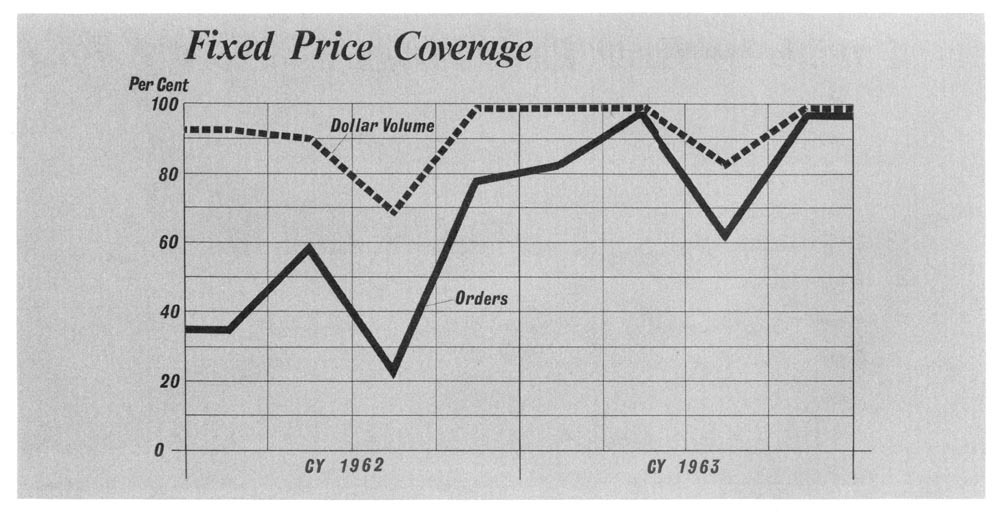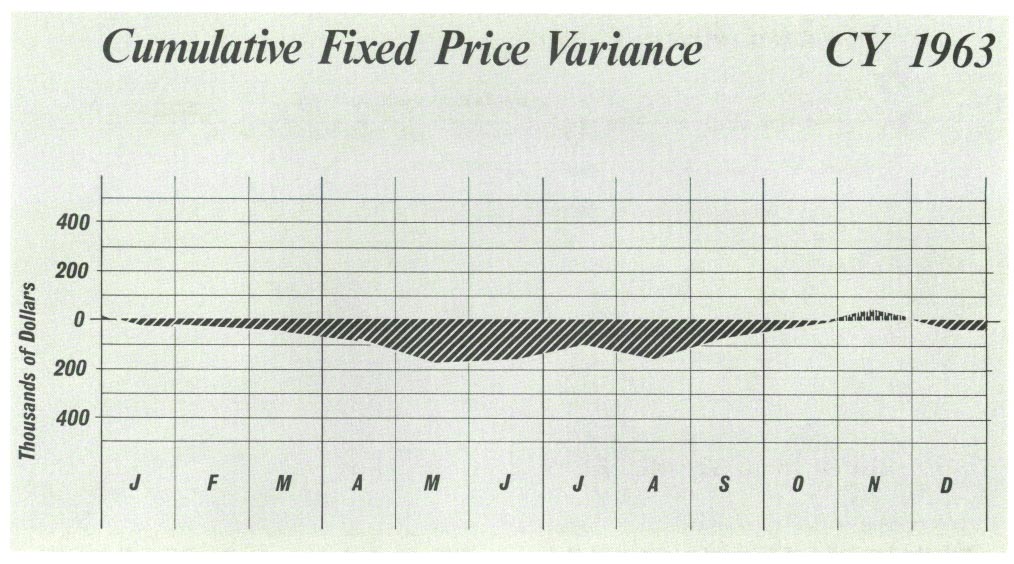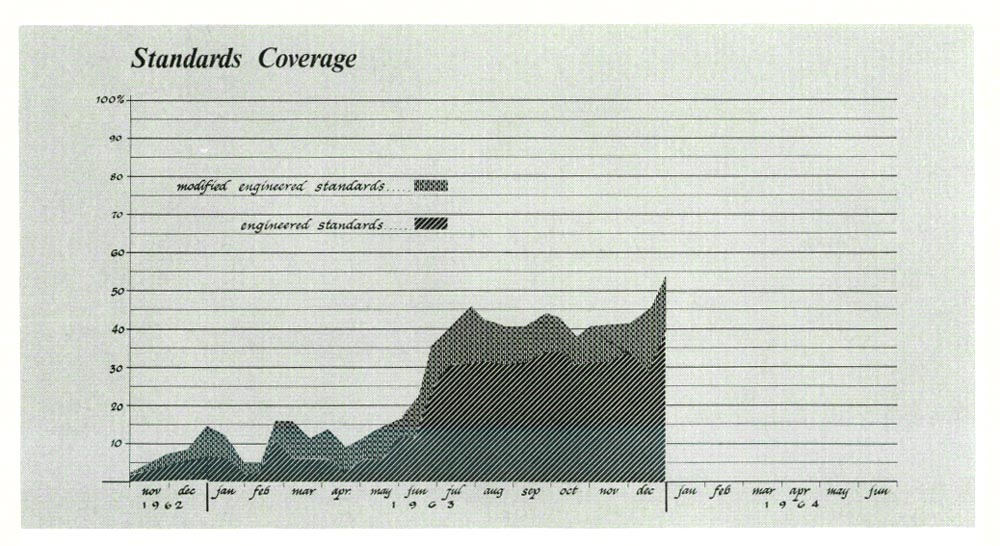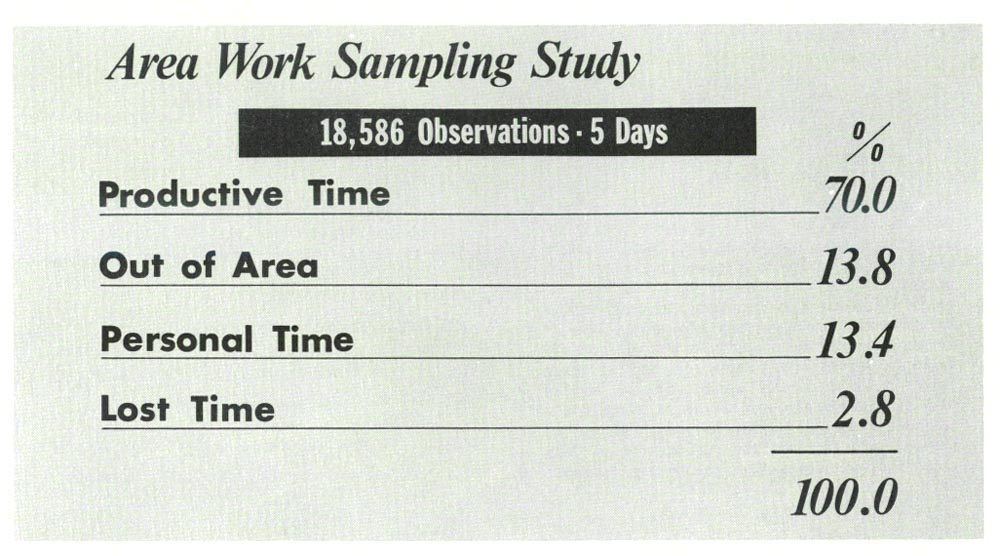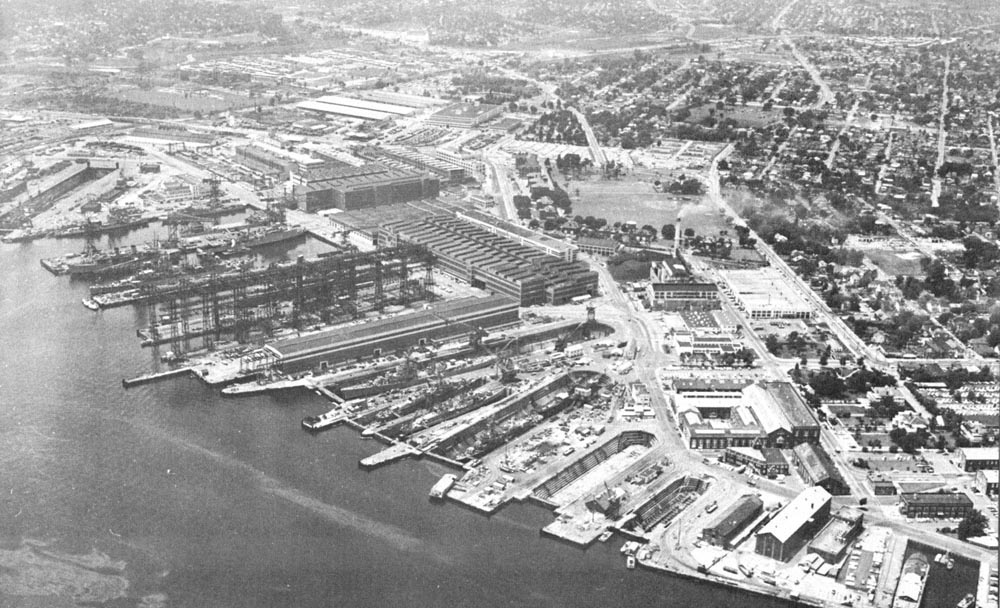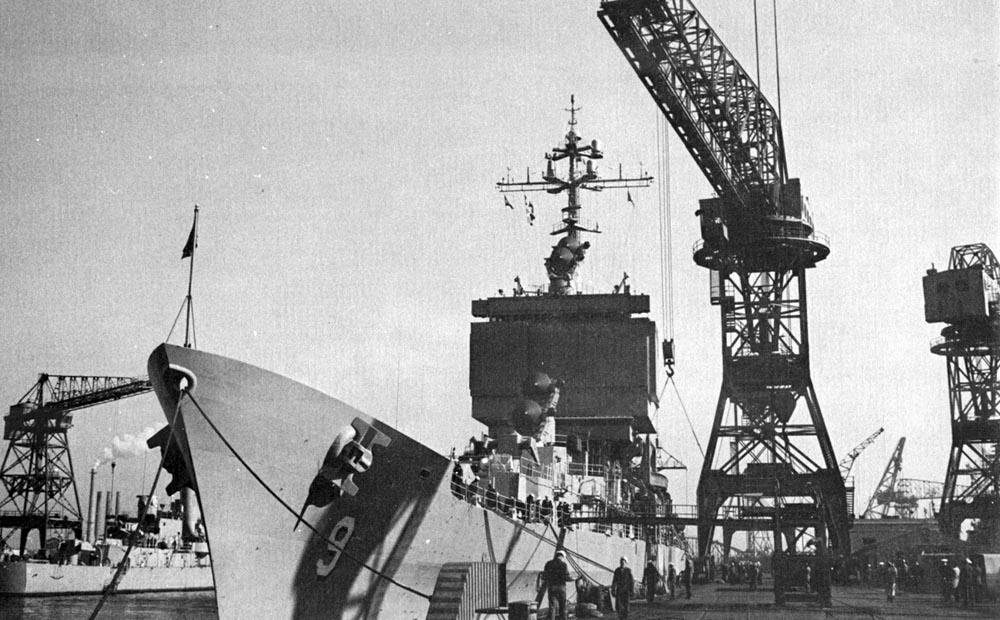NORFOLK NAVAL SHIPYARD
Portsmouth, Virginia
Reviewed and Approved for printing in accordance
with SECNAV INST 5600.15 on 11 March 1964.
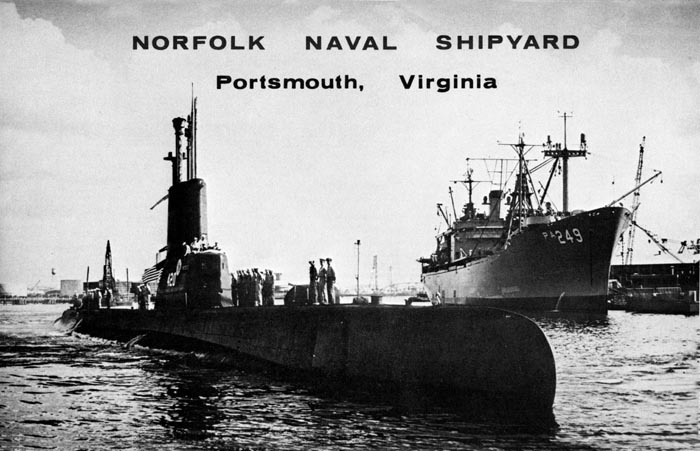

FOREWORD
This booklet has been prepared to acquaint interested persons with the capabilities and performance of the Norfolk Naval Shipyard.
This Shipyard enjoys an excellent reputation with the Fleet. That reputation has been earned through the ingenuity and conscientious efforts of a dedicated work force of mechanics, technicians and managerial personnel. Working vigorously to overcome the obstacles of rising costs and increasingly complex technologies, Norfolk Naval Shipyard seeks to retain its position of prominence through the decades ahead, demonstrating ever more fully the meaning of its motto, "Service to the Fleet".
J. M. FARRIN
Rear Admiral, USN
CommanderTHE NORFOLK NAVAL SHIPYARD MISSION
1. To perform authorized work in connection with construction, conversion, overhaul, repair, alteration, drydocking and outfitting of ships and craft as assigned.
2. To perform manufacturing, research, development and test work as assigned.
3. To provide support for assigned ships and service craft.
4. To provide services and material to other activities and units as directed by competent authority.
Aerial view of Norfolk Naval Shipyard
A BRIEF HISTORY
The Norfolk Naval Shipyard is the oldest Naval Shipyard in the United States. Established in 1767, it has felt the impact of nine wars and from its staff have flown the flags of four sovereign powers.
The Shipyard is the nucleus from which the great Hampton Roads Naval complex has grown. Through its long history, it has attained a number of priorities of which it is justly proud:
• The U. S. frigate CHESAPEAKE, first ship to be constructed for the U. S. Navy Department, was built here in 1798-99.
• On 17 June 1833, the U. S. ship DELAWARE entered the Shipyard's newly constructed Drydock 1, becoming the first vessel drydocked in America. Drydock 1 is still used daily in repair of fleet-type submarines and smaller surface craft.
• The Confederate States Ship VIRGINIA, better known by its former name, MERRIMAC, was converted in this Shipyard from a partly burned Union frigate to the world's first armored ship to engage in battle. Her battles in Hampton Roads March 8 and 9, 1862 with the Union's wooden squadron and the armored MONITOR made naval history.
• USS TEXAS, the Navy's first battleship, was built here in 1889-92.
• The Navy's first aircraft carrier, USS LANG-LEY, was converted by this Shipyard in 1919-22 from the collier JUPITER.
During World War II, Norfolk Naval Shipyard demonstrated its new construction capability in building three carriers, one battleship, sixteen destroyers and destroyer escorts and numerous LST's and smaller craft. Two non-magnetic minesweepers of laminated wood construction were built here during the Korean hostilities. Since this time, the Shipyard has been exclusively engaged in repair and conversion of Naval vessels, including the largest attack carriers and the latest guided missile cruisers and destroyers.
USS VALCOUR (AVP-55) in Drydock No. 1
PRODUCTIVE CAPABILITIES
Norfolk Naval Shipyard has always maintained the capability to drydock the largest vessels in the Navy. Except for nuclear power plants, training for which will be completed in 1964, there is no major shipboard system or component which this Shipyard is incapable of servicing.
The Design Division is staffed with experienced engineers and technicians who are well acquainted with the peculiar problems to be encountered in major repair and conversion work. The original Polaris system installation aboard USS OBSERVATION ISLAND (EAG-154) was planned by the Norfolk Naval Shipyard Design Division and this system has been periodically updated to allow firing of Polaries missiles of the latest configuration. Complete plans for destroyer FRAM conversions have been developed here and used by Naval Shipyards on both coasts. Design work is presently underway on a streamlined LST bow ramp design — a completely new concept which will allow an increase in sustained speed from 10 to 20 knots while retaining the present reliability and ease of offloading.
In sophisticated electronics and weapons systems, the Combat Systems Division provides skilled field engineering services to the Navy throughout the Norfolk area. Complete inspections of all weapons systems and electronics gear are made prior to Shipyard overhaul of each missile ship so that the Commanding Officer and the Type Commander may be given a comprehensive report of the deficiencies and true combat capabilities of the vessel. Thus informed, maximum combat effectiveness may be achieved during the forthcoming overhaul with minimum expenditure of funds.
The various shops of the Production Department are completely equipped to perform every phase of ship repair work. In addition to their shipboard work, Shipyard mechanics are frequently called upon to perform installation and maintenance work at nearby shore activities. For example, the greater portion of the complex electronics and weapons systems at the Fleet Air Defense Training Center, Dam Neck, Virginia was installed and continues to be serviced by Norfolk Naval Shipyard technicians. The Shipyard's shop facilities and skilled mechanics are often utilized by other Naval activities and NASA in fabrication and machine work beyond the capabilities of commercial contractors or other Government facilities in this area.
Two Naval Shipyard activities are located outside the Shipyard boundaries. The Electronics Maintenance Engineering Center, located at the U. S. Naval Base, Norfolk, is charged with the responsibility of monitoring and evaluating Fleet experience with all types of radio, radar and sonar equipment in order to increase reliability and reduce equipment "down-time," through recommendation of appropriate design changes and maintenance procedures. The Acoustic and Pressure Check Range Division at Fort Story, Virginia, performs sonar alignment for surface ships.
Recognizing the increasing importance of our submarine forces in both Polaris and ASW functions, the Shipyard is pressing the early completion of nuclear power facilities and personnel training in order to provide full service to all shipboard systems of the Navy's undersea fleet. The present implementation of Quality Control techniques will be further expanded during the coming years to insure that the quality of the Shipyard's work remains uniformly high despite the need for quicker, less costly means of repair and maintenance. The Shipyard is confident that its imposing record of past accomplishments will be surpassed by even more outstanding achievements in the years ahead.
Polaris Submarine USS THOMAS A. EDISON in Drydock 4.
MILITARY SUPPORT FACILITIES
Personnel attached to Naval vessels undergoing overhaul and major repair must be provided with berthing, messing, office and work space. Norfolk Naval Shipyard is completely equipped to meet these needs:
• The Shipyard can provide berthing and mess facilities for 84 officers and 2,200 enlisted men per day.
• A Commissary and Navy Exchange are available to serve these men and their dependents.
• A theater, bowling alley, gymnasium, swimming pool and other recreational facilities are provided within the Shipyard.
• Ample work space, tools and utilities are available for use of ship personnel in performing those repair tasks which are within their capabilities, reducing appreciably the cost of a major overhaul.
• Cryptographic and Compressed Gases Schools in the Shipyard are conducted for Naval personnel on a continuous basis. In addition, the Marines' Sea School is located in the Shipyard Marine Barracks.
Provision of adequate military support facilities is of primary importance in submarine repair work since the limited living space on board must be completely vacated to allow repairs of any magnitude to be accomplished.
IMPACT ON LOCAL ECONOMY
While an industrial operation of the size of Norfolk Naval Shipyard would be an asset to any community, its importance to the cities of Southeastern Virginia can hardly be exaggerated. With an annual civilian payroll of $75 million, it is the largest employer in the Norfolk-Portsmouth area.
The local economy is further swelled by approximately $7.6 million in local purchases made by the Shipyard each year. Market studies have shown that fifty percent of the take-home pay of the people of Portsmouth and Chesapeake, regardless of employment (i.e., banker, grocer, druggist, etc.), originates from wages paid at the Shipyard.
Norfolk Naval Shipyard has the facilities and space to accept large increases in workload. The employment peak of 16,100 reached during the Korean hostilities is close to the optimum of 17,000 calculated in a study initiated by the Bureau of Ships in January 1964 (below).
OPERATION THRIFT
One of the Shipyard's most important goals for Fiscal Year 1954 is full implementation of "Operation Thrift", the Department of Defense Cost Reduction Program. The Shipyard's performance in this program is encouraging except for the area "Elimination of Gold Plating"; to remedy this situation, the Value Engineering Branch has been reestablished with the specific mandate of implementing and documenting all possible cost-reducing improvements in ship repair and conversion. Thrift totals as of March 1964 are as follows:
ApprovedElimination of Gold Plating Equipment Maintenance
(Cost Avoidance)Administrative Vehicles Real Property Management Packing, Packaging & Preservation Totals (14 Feb 1994) MANAGEMENT ACTIONS DESIGNED TO REDUCE OPERATING COSTS
The following examples are cited to indicate the Shipyard's recent progress in reducing operating costs:
A. Civilian guards have been removed from gates at currently-inactive St. Helena Annex,
formerly manned 24 hours per day, 7 days a week. An "open-gate" policy has been adopted, with signs warning that trespassers will be prosecuted. Yearly savings: $27,500.B. Non-replacement of retiring supervisory and overhead employees where duties can be absorbed by others has produced a yearly saving of $189,101. Included in the positions abolished were two Shop Masters, one GS-13 Supervisory Engineer, three Quartermen, one Chief Quarterman, nine Leadingmen and six shop planners.
C. Financial records formerly kept manually were transferred to electrical accounting machines, eliminating five clerical positions. Yearly savings: $30,382.
D. Random inspections of rail cars routed to the Shipyard dump revealed an average of $70 worth of scrap metal in each car. Twelve cars per day are delivered to the dump, which is contracted to private interests. Pier Superintendents now thoroughly inspect each car before authorizing its removal, thereby reclaiming (for later sale or reuse) many tons of scrap metal. Yearly savings amount to $211,680.
The above chart illustrates the effects of a concerted drive to reduce the number of overhead employees, begun by this Shipyard in 1960. To date, overhead employment has been reduced by approximately 500.
SHIP REPAIR IN COMMERCIAL SHIPYARDS
In his capacity as Industrial Manager, Fifth Naval District, the Shipyard Commander administers the repair and conversion of Naval vessels in private shipyards in Virginia, North Carolina, Maryland and Delaware. IndMan completed contracts during calendar years 1962 and 1963 amounted to the following:
Original Contracts Change Orders New Works Total Total The capability of private shipyards to handle major ship repairs is principally measured in drydock capacity. Newport News Shipbuilding and Drydock Company can, of course, handle ships of all sizes and types. Norfolk Shipbuilding, Bethlehem Steel and Maryland Shipbuilding are limited to the older AO class vessels or smaller. No other private yard in the District can accommodate vessels larger than DE's and the smallest yards are utilized only for repairs to small boats and minor landing craft.
Above: The Shipyard Supply Department is a most important asset in Fleet Support work. The aerial view shows a portion of our Supply storage area where an industrial material inventory of $160 million is maintained.
The Shipyard's Retained Earnings during Calendar Year 1963 were held reasonably close to the optimum zero by judicious assignment of the Applied Overhead Rate. The gradual climb in Retained Earnings during the latter half of the year resulted from a declining actual overhead rate while the applied rate was held constant at $2.70 per direct labor man0hour, in anticipation of the January 1964 increase of 4-1/2% in Group IVb salaries. The peak figure of $640,000 (December 1963) is actually on 0.54% of the Shipyard's total billing of approximately $120,000,000 in Fiscal Year 1963.
Fixed Pricing refers to the practice of establishing a firm total price for an overhaul at the earliest possible time, usually no later than the mid-point of the availability. Recognizing that this affords great advantages to Type Commanders in allocation of their repair funds, the Shipyard has vigorously implemented this policy whenever possible. The above chart shows that in Calendar Year 1963, coverage of orders subject to Fixed Pricing approached 100% both in Dollar Volume and Number or Orders.
The above chart reflects the accuracy of Fixed Prices applied during the calendar year 1963. The area below the zero line indicates an estimate under the actual price, while the above the zero line indicates a gain. It may be noted that the maximum variance of Cumulative Fixed Price during the period charted is less than 0.15% of total billings for the year.
It is the firm belief of Shipyard management that extensive application of Standard Methods and Standard Allowances is one of the best means of controlling direct labor costs. While the diverse nature of repair work prevents achievement of 100% standards coverage, the Shipyard's recent success in applying work standards to recurring jobs is shown on the above chart. The plotted values represent the percentages of total work issued covered by such standards.
The Shipyard regularly makes use of work sampling techniques on both direct labor and overhead employees. The above tabulation presents a summary of a very large number of observations conducted over a five-day period during the GRAM I conversion of USS HOLDER (DD-819) in late 1963. The "work time" percentage of 70% is considered very good for waterfront work.
PLANT IMPROVEMENTS
Improvements in plant equipment offer a positive means of achieving significant reductions in overhaul costs, particularly if these improvements are amortized in a reasonably short time. Many such objectives were described fully in recent Shipyard Modernization Proposals. Other improvements are absolutely necessary to merely keep pace with the changes in ship design; for example, during WW I destroyers had a pierside power demand of 200 amps. By the end of WW II, this had risen to 350 amps. Guided missile destroyers now require 750 amps and current shipalts will increase the requirement to 1500 amps when completed. Thus the primary emphasis in this Shipyard's Military Construction has been on Utilities Improvement and the completion of Nuclear Ship Overhaul Facilities.
Funds available for plant improvements in recent years have been:
FY 1962 —Nuclear Ship Overhaul
Facilities: $211,000
Utilities Improvement: $2,790,000
FY 1963 —Nuclear Ship Overhaul
Facilities: $452,000
Utilities Improvement: $1,300,000
FY 1964 — Deepening Drydock No. 2 $5,300,000
Norfolk Naval Shipyard aerial view.
THE FUTURE
Norfolk Naval Shipyard eagerly anticipates the beginning of Nuclear overhaul work during the latter half of 1964. The Shipyard's adaptability to submarine work has been successfully demonstrated in the completion of numerous fleet-type submarine overhauls since 1961; the start of nuclear work will complete the Shipyard's capability to do all types of repair and overhaul on all types of ships.
The increasing application of work standards and the vigorous implementation of Quality Assurance and Value Engineering principles are being counted upon to produce substantial savings in overhaul costs during the coming months. Goals are being set for the larger projects to impress upon all personnel the vital concern with costs: for each of the three FRAM I Destroyer conversions started this year, a 10% reduction in total price is actively sought.
The years ahead are likely to see great changes in the composition of our naval forces. The Polaris system is rapidly reaching its planned strength, while once-rare guided missile destroyers have become a common sight in our drydocks and berths. With the threat to be expected in the near future from enemy missile-launching submarines, there will probably be major naval weapons emphasis on the fast nuclear attack submarine. Such rapid shifts in our defense planning to missiles and underwater attack forces call for an equal flexibility in Shipyard capabilities and attitudes. The enthusiastic response of Norfolk Naval Shipyard personnel to training programs currently under way is ample proof of the proper attitude, particularly among the younger engineers and mechanics who will become the mainstays of our work force in the future.
Norfolk Naval Shipyard is the largest shipyard in the world exclusively devoted to repair and conversion. Its management exerts every effort to see that it remains also the BEST.
JIM FARRIN
Reviewed and Approved for printing in accordance with SECNAV INST 5600.15 on 11 March 1964.
THE END.
Site Table of Contents
Site Index
Portsmouth Table of Contents
Norfolk Table of Contents
Chesapeake Table of Contents


